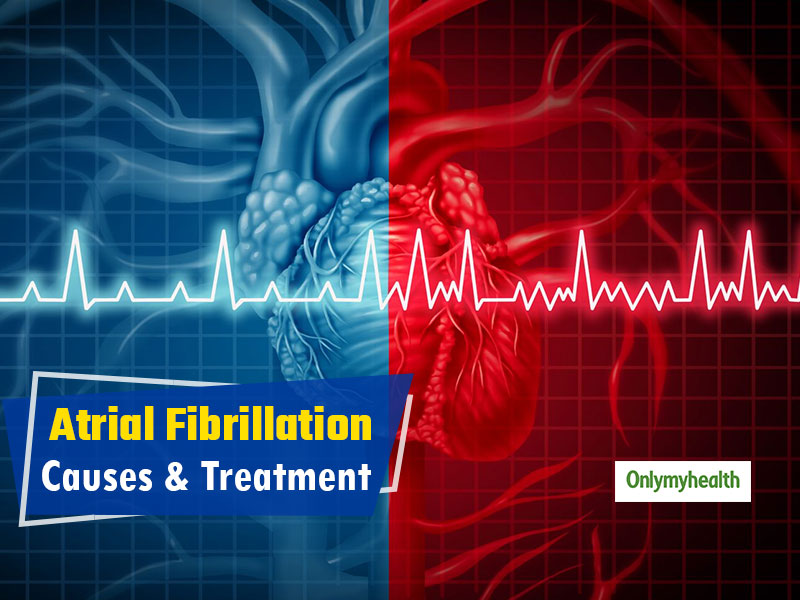
The heart starts beating right from early conception till our death. Heartbeats roughly more than one lakh times a day. Usually the heart beats regularly with separation between two heartbeats nearly equal. Heart beats and resultant pulse felt in our wrist is due to electrical activity of the heart. Normally an electrical impulse originates from the top right part of the heart called sinus node, then it travels down, and when it reaches the main muscular part of heart, the heartbeats sending blood to the body. Sinus node sends electrical impulses 60 to 100 times a min to generate blood flow and hence supplying blood to our organs, which sustains life. When the demand of body increases like during running or mental stress, heartbeat rise more than 100 beats per min. However, this increase in heart rate is regular, and all beats originate from the sinus node, the natural pacemaker.
Table of Content:-
What Is Atrial Fibrillation

Atrial fibrillation is a medical condition where the origin of heartbeats is chaotic, and all beats originate from different parts of atria, the receiving chambers of heart and sinus node no longer controls the pacing activity of the heart. Heartbeats arising due to this disturbed electrical activity are irregular and can be very fast with heart rates going more than 100 to 200 beats per min.
Also Read: Few Tips To Strengthen Your Heart by Dr Narayan Gadkar
The patient develops symptoms of palpitations, that is abnormal and unpleasant awareness of one’s heartbeat, fatigue, sometimes accompanied by giddiness or difficulty in breathing. Many times these palpitations and breathing difficulty is severe enough to require emergency department visits and hospitalization. Chronic patients whose heart rate is irregular but rate controlled by medications may be symptomatic. Apart from symptoms, this irregularity of heart rate increases risk of clot formation in the heart. If this clot travels to the brain, it can cause stroke, which can be life-threatening or disabling enough to reduce the quality of life.
Causes Of Atrial Fibrillation

Atrial fibrillation is the most common rhythm problem for which patients are hospitalized and also the most commonly treated rhythm problem. Atrial fibrillation increases the risk of stroke five times and increases risk of death two-fold. Significant causes of atrial fibrillation are:
- High blood pressure
- Heart disease
- Reduced pumping function of heart
- Narrowing or leakage of heart valves
- Abnormal stiffness of heart which can be age-related, alcohol consumption, obesity, lung or thyroid disorders
Also Read: World Heart Day 2019: Soha Ali Khan And Milind Soman Share Secrets For A Healthy Heart
Treatment of Atrial Fibrillation

When any patient presents with this rhythm disorder, patients are initially assessed for cause and treatment plan is formulated. Simultaneously patients are treated for their symptoms, and blood thinners are started to reduce risk of stroke or similar clot-related problems in other organs. If the patient heart rate is high, medications are started to reduce the heart rate to normal limits or attempt is made to revert this to normal sinus rhythm if possible. Control of heart rate alone brings relief to the patient. Majority of patients require blood thinners for lifelong to reduce their risk of stroke or other blood clot-related problems. Even patients with intermittent atrial fibrillation are at high risk and need blood thinners.
Newer blood thinners do not require monitoring with blood tests. These new drugs can be used in the majority of patients with atrial fibrillation except patient with mechanical heart valves or inpatient with damaged or narrowed heart valves. In these patients’ conventional blood thinners are used, which require monitoring by a blood test at least at monthly duration. Few selected atrial fibrillation patients, especially younger ones with a relatively healthy heart, can benefit from catheter-directed ablation therapies, in which radiofrequency waves burn abnormal circuits in the heart. The procedure lasts 1 to 3 hours, and the patient can be discharged from hospital very next day.
Medications and treatment plan depending upon the patient’s heart condition and individual risk of developing stroke or any other blood clot-related problems. With proper medications and treatment, these patients can have a near-normal quality of life and improved survival.
With inputs from Dr Rupesh Kaushik, Senior Consultant, Cardiology, Aakash healthcare, Dwarka
Read more articles on Heart Health
How we keep this article up to date:
We work with experts and keep a close eye on the latest in health and wellness. Whenever there is a new research or helpful information, we update our articles with accurate and useful advice.
Current Version
